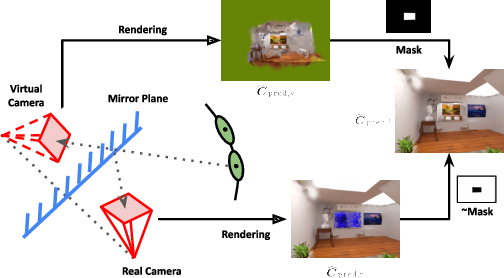Gaussian Splatting in Mirrors: Reflection-Aware Rendering via Virtual Camera Optimization
Paper and Code
Oct 02, 2024



Recent advancements in 3D Gaussian Splatting (3D-GS) have revolutionized novel view synthesis, facilitating real-time, high-quality image rendering. However, in scenarios involving reflective surfaces, particularly mirrors, 3D-GS often misinterprets reflections as virtual spaces, resulting in blurred and inconsistent multi-view rendering within mirrors. Our paper presents a novel method aimed at obtaining high-quality multi-view consistent reflection rendering by modelling reflections as physically-based virtual cameras. We estimate mirror planes with depth and normal estimates from 3D-GS and define virtual cameras that are placed symmetrically about the mirror plane. These virtual cameras are then used to explain mirror reflections in the scene. To address imperfections in mirror plane estimates, we propose a straightforward yet effective virtual camera optimization method to enhance reflection quality. We collect a new mirror dataset including three real-world scenarios for more diverse evaluation. Experimental validation on both Mirror-Nerf and our real-world dataset demonstrate the efficacy of our approach. We achieve comparable or superior results while significantly reducing training time compared to previous state-of-the-art.
 Add to Chrome
Add to Chrome Add to Firefox
Add to Firefox Add to Edge
Add to Edge